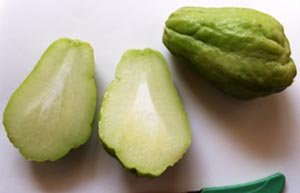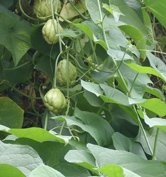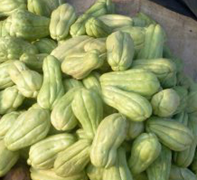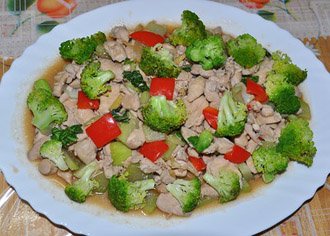Chayote (mirliton) Nutrition facts
Chayote squash, also known as mirliton in the US, is a pear-shaped light green vegetable in the gourd family. It is one of the well-recognized field plants in many mid-American regions and some southern US states like California, Louisiana, and Florida.
Some of the common names are mirlitons, vegetable pear, chocho, sayote, christophine, and so on.
Botanically, it belongs to the broad Cucurbitaceae (gourd) family of vegetables, which also includes cucumber, pumpkin, and squash. Scientific name: Sechium edule.
 |
| Chayote pear with cut sections. |
Chayote squash is a perennial vine that climbs on support by clinging with tenacious tendrils. It requires well-drained moist soil and a long, warm growing season to flourish. In their natural habitat, mirlitons run along over fences, shrubs, and even on straight-up trees. In the cultivated farms, however, the crop is supported by a strong trellis. The vine produces small, white, monoecious (separate male and female) flowers.
 |
| Mirliton pears on a vine. |
Chayote pears mature and ready for harvest after about 30 days of pollination. Each plant may yield up to 150 fruits in a season. The fruit has thin, pale green skin and several shallow vertical furrows running on the surface. Some types have spiky or fuzzy surfaces while others feature smooth skin. Inside, its pale white flesh surrounds a central cream-white seed ovule.
It features a crunchy texture and mildly sweet taste that may be comparable to butternut squash or pumpkin.
Health benefits of Chayote
Chayote like pumpkin is one of the vegetables that is very low in calories; provides just 16 calories per 100 g and contains no saturated fats or cholesterol. However, it is rich a source of dietary fiber, anti-oxidants, minerals, and vitamins. Being a low-calorie and fiber-rich vegetable; dieticians often recommend it in cholesterol-controlling and weight-reduction programs.
They are relatively good sources of the B-complex vitamin, folates. 100 g fresh mirliton carries 93 µg or 23% of the daily recommended intake. Folates are essential for cell division, and DNA synthesis. When taken adequately before and during early pregnancy, this vitamin can help prevent neural tube defects in newborn babies.
As in other gourd family vegetables like zucchini, chayote too provides moderate levels of potassium. 100 g fresh fruit contains 125 mg or 2.5% of the recommended daily requirements of this electrolyte.
Furthermore, chayote contains small levels of aglycone flavonoid polyphenolic antioxidants such as apigenin and luteolin. These compounds help scavenge harmful oxygen-derived free radicals and reactive oxygen species (ROS) from the body that play a role in cancer, aging, and various disease processes.
Fresh mirliton-pears are adequate sources of antioxidant vitamin C. Provide about 7.7 mg or 13% of RDA per 100g.
Further, they are also good in a B-complex group of vitamins like thiamin, pyridoxine, riboflavin, and minerals like iron, manganese, phosphorus, zinc, and copper.
| Principle | Nutrient Value | Percent of RDA |
|---|---|---|
| Energy | 19 Kcal | <1% |
| Carbohydrates | 4.51 g | 3.5% |
| Protein | 0.82 g | 1.5% |
| Total Fat | 0.13 g | <1% |
| Cholesterol | 0 mg | 0% |
| Dietary Fiber | 1.7 g | 4.5% |
| Vitamins | ||
| Folates | 93 µg | 23% |
| Niacin | 0.470 mg | 3% |
| Pantothenic acid | 0.249 mg | 5% |
| Pyridoxine | 0.076 mg | 6% |
| Riboflavin | 0.029 mg | 2% |
| Thiamin | 0.025 mg | 2% |
| Vitamin A | 0 IU | 0% |
| Vitamin C | 7.7 mg | 13% |
| Vitamin E | 0.12 mg | <1% |
| Vitamin K | 4.1 µg | 4% |
| Electrolytes | ||
| Sodium | 2 mg | <1% |
| Potassium | 125 mg | 2.5% |
| Minerals | ||
| Calcium | 17 mg | 1.7% |
| Iron | 0.34 mg | 4% |
| Magnesium | 12 mg | 3% |
| Manganese | 0.189 mg | 8% |
| Phosphorus | 18 mg | 2.5% |
| Selenium | 0.2 µg | <1% |
| Zinc | 0.74 mg | 7% |
| Phyto-nutrients | ||
| Carotene-ß | 0 µg | -- |
| Crypto-xanthin-ß | 0 µg | -- |
| Lutein-zeaxanthin | 0 µg | -- |
Selection and storage

|
| Chayote pears in a market. |
Mirlitons begin available in the US markets from October through April. However, they can be found year-round in some Latin American and Asian markets. While buying, choose medium-sized fresh apple-green color firm fruits. Large, overmature pears have a tougher skin and stringy pulp, which may be undesired in cooking and unappetizing.
Avoid old stock, as they tend to sprout early. Furthermore, look for surface cuts, pits, cracks, or bruises and avoid them. Minor superficial scratches and mild bruises often appear on their surface but are perfectly fine.
At home, place them in a paper bag and store them inside the vegetable compartment of the home refrigerator set at adequate moisture. They may be retained for up to 2-3 weeks. Old and large mirliton pears tend to sprout quite early, so use them as soon as possible.
Preparation and serving methods
Chayote pears have a mild sweet taste and crispy texture that makes them a suitable veggie item in the preparation of raw salads and slaws.
To prepare, wash the chayote thoroughly in cold running water just before cooking. Sometimes, it may require a light scrub at places where prickles or dirt are attached firmly. Trim at stem-end and bases.
Peeling of skin is not required in young, tender pears. However, larger and over-mature fruits need light peeling using a vegetable peeler. Raw chayote exudes a sticky liquid (sap) when peeled that can cause skin irritation and occasionally some numbness in hands and fingers. It may advise peeling them under cold running water or using protective gloves.
Young tendrils, flower blossoms, as well as its root (tuber) are also being used in cooking.
 |
| Chicken recipe with chayote, broccoli, and bellpepper. Photo courtesy: whologwhy |
Here are some serving tips:
Raw mirlitons cut into chunks/cubes are added to fruit and vegetable salads.
Add chopped, julienned thin pieces mixed with cabbage, parsnips, beet to coleslaws.
Stuff chayote pears with seafood ('Shrimp and Crab stuffed chayote') or complementing vegetables like sweet pepper, onion, corn, mushroom, and cheese to prepare mouthwatering recipes.
In some South Indian states, it is employed in stir-fries, curry, soups, and stews.
It is used in confectionary to prepare casseroles, pie (New Orleans mirliton pie), cake, bread…etc.
It is used in confectionary to prepare casseroles, pie (New Orleans mirliton pie), cake, bread…etc.
In Tamilnadu, it is known as maerakkai (மேரக்காய்) or chow chow, found favorite in lentil-curry (chow chow kootu/ maerakkai kuzhambu) served with steamed rice.
Safety profile
Chayote pears exude a clear latex-like liquid, especially while peeling. This latex can cause peculiar tingling sensations and numbness while handling it with bare hands. The sticky fluid is believed to cause some kind of "transient anesthetic contact reaction". This effect, however, is self-limiting and has no long-lasting consequences. It can be minimized by using protective gloves or by peeling in cold running water. (Medical disclaimer).
≻≻-Back to Vegetables from Chayote. Visit here for an impressive list of vegetables with complete illustrations of their nutrition facts and health benefits.
≻≻-Back to Home page.
Further reading and Resources:
Stanford School of Medicine Cancer information Page- Nutrition to Reduce Cancer Risk.
Sechium edule-pdf.